
Catalog excerpts

02• 2009 WORLD B e a m e x c o r p o r a t e m a g a z i n e • w w w. b e a m e x . c o m Customer success stories Siemens Energy Fossil - Field Service, UK Total Petrochemicals USA Inc., USA Croda Chemicals Europe Ltd., UK Nokian Tyres, Finland Endress+Hauser, Germany Why Calibrate? What is the risk of not calibrating?
Open the catalog to page 1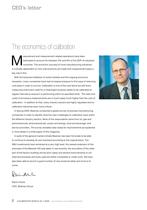
Measurement and measurement-related operations have been estimated to account for between 3% and 6% of the GDP of industrial countries. The economic success of most manufacturing industries is critically dependent on how well products are made and measurement plays a key role in this. With the financial meltdown of world markets and the ongoing economic recession, many companies have had increased pressure to find ways of reducing cost base in order to survive. Calibration is one of the cost items but still every measuring instrument used for a meaningful purpose needs to be calibrated at...
Open the catalog to page 2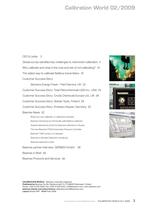
Calibration World 02/2009 CEO’s Letter 2 Global survey identifies key challenges to instrument calibration 4 Why calibrate and what is the cost and risk of not calibrating? 10 The safest way to calibrate fieldbus transmitters 16 Customer Success Story: Siemens Energy Fossil – Fiel d Service, UK 22 Customer Success Story: Total Petrochemicals USA Inc., USA 24 Customer Success Story: Croda Chemicals Europe Ltd., UK 26 Customer Success Story: Nokian Tyres, Finland 28 Customer Success Story: Endress+Hauser, Germany 30 Beamex News 32 Build your own calibrator or calibration software Beamex...
Open the catalog to page 3
Global survey identifies key challenges to instrument calibration 4 CALIBRATION WORLD 02 • 2009 www.beamex.com/calibrationworld
Open the catalog to page 4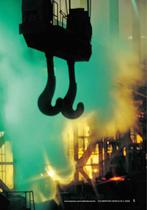
www.beamex.com/calibrationworld CALIBRATION WORLD 02 • 2009 5
Open the catalog to page 5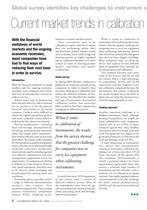
With the financial meltdown of world markets and the ongoing economic recession, most companies have had to find ways of reducing their cost base in order to survive. Introduction With the financial meltdown of world markets and the ongoing economic recession, most companies have had to find ways of reducing their cost base in order to survive. Almost every type of business has been affected either by a fall in demand for its products or by the general financial uncertainty in the world economy. Credit is more difficult to obtain for capital expenditure projects and many companies cannot...
Open the catalog to page 6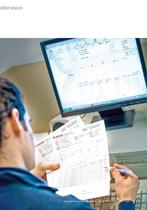
calibration www.beamex.com/calibrationworld CALIBRATION WORLD 02 • 2009 7
Open the catalog to page 7
This problem is particularly acute in those industries where instrument calibration is managed manually (paper-based) or on a semi-manual basis (Microsoft Access, Excel, etc.). For example, in oil, gas & petrochemicals, 43.1% of respondents said that their calibration management system was semi-manual; with another 15.3% saying their system was paper-based. Only 22.8% in these industries said their system was managed by specialist calibration management software. Documentation errors Another important challenge identified by respondents was ‘documentation errors’, which more than a third of...
Open the catalog to page 8
calibration www.beamex.com/calibrationworld CALIBRATION WORLD 02 • 2008 9
Open the catalog to page 9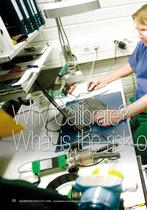
Why Calibrate? What is the risk o 10 CALIBRATION WORLD 02 • 2009 www.beamex.com/calibrationworld
Open the catalog to page 10
o f not calibrating? www.beamex.com/calibrationworld CALIBRATION WORLD 02 • 2009 11
Open the catalog to page 11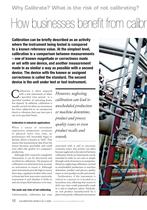
Calibration is often required with a new instrument or when a specified time period or a specified number of operating hours has elapsed. In addition, calibration is usually carried out when an instrument has been subjected to an unexpected shock or vibration that may have put it out of its specified limits. Calibration in industrial applications When a sensor or instrument experiences temperature variations or physical stress over time, its performance will invariably begin to decline, which is known as ‘drift’. This means that measurement data from the sensor becomes unreliable and could...
Open the catalog to page 12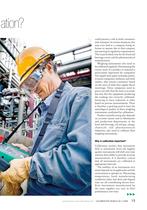
ation? could present a risk to both consumers and customers. In certain situations, this may even lead to a company losing its license to operate due to that company not meeting its regulatory requirements. This is particularly true for the food and beverage sector and for pharmaceutical manufacturers. Weighing instruments also need to be calibrated regularly. Determining the correct mass of a product or material is particularly important for companies that supply steel, paper and pulp, power, aviation companies, harbours and retail outlets, who invoice customers based on the mass of what...
Open the catalog to page 13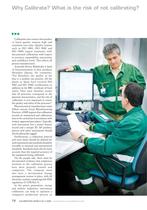
Why Calibrate? What is the risk of not calibrating? Calibration also ensures that product or batch quality remains high and consistent over time. Quality systems such as ISO 9001, ISO 9002 and ISO 14001 require systematic, welldocumented calibrations with respect to accuracy, repeatability, uncertainty and confidence levels. This affects all process manufacturers. Armando Rivero Rubalcaba is head of Instrumentation at beer producer Heineken (Spain). He comments: “For Heineken, the quality of the beer is a number one priority. All the plants in Spain have received ISO 9001 and ISO 14001...
Open the catalog to page 14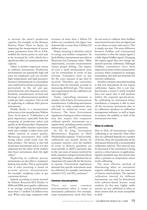
to increase the plant’s production capacity. For example, at the Almaraz Nuclear Power Plant in Spain, by improving the measurement of reactor power parameters from 2% to 0.4%, enabled the reactor power in each unit to be increased by 1.6%, which has a significant effect on annual production capacity. Safety is another important reason to calibrate instruments. Production environments are potentially high risk areas for employees and can involve high temperatures and high pressures. Incorrect measurements in a hazardous area could lead to serious consequences, particularly in the oil and...
Open the catalog to page 15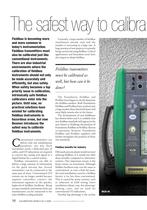
The safest way to calibra Fieldbus is becoming more and more common in today’s instrumentation. Fieldbus transmitters must also be calibrated just like conventional instruments. There are also industrial environments where the calibration of fieldbus instruments should not only be made accurately and efficiently, but also safely. When safety becomes a top priority issue in calibration, intrinsically safe fieldbus calibrators enter into the picture. Until now, no practical solutions have existed for calibrating fieldbus instruments in hazardous areas, but now Beamex introduces the safest way...
Open the catalog to page 16All Beamex catalogs and technical brochures
-
Brochure - Software and services
44 Pages
-
MC6-Ex
16 Pages
-
Beamex smart reference p
2 Pages
-
Beamex MC2-IS
12 Pages
-
MCS200
18 Pages
-
Calibration World spring 2016
36 Pages
-
Brochure - Workshop Equipment
54 Pages
-
Brochure - Field Equipment
116 Pages
-
Brochure - Calibration Solutions
36 Pages
Archived catalogs
-
Calibration World 2-2007
24 Pages
-
Calibration World Issue 1-2007
24 Pages
-
Calibration World Issue 1-2006
24 Pages




















































































































